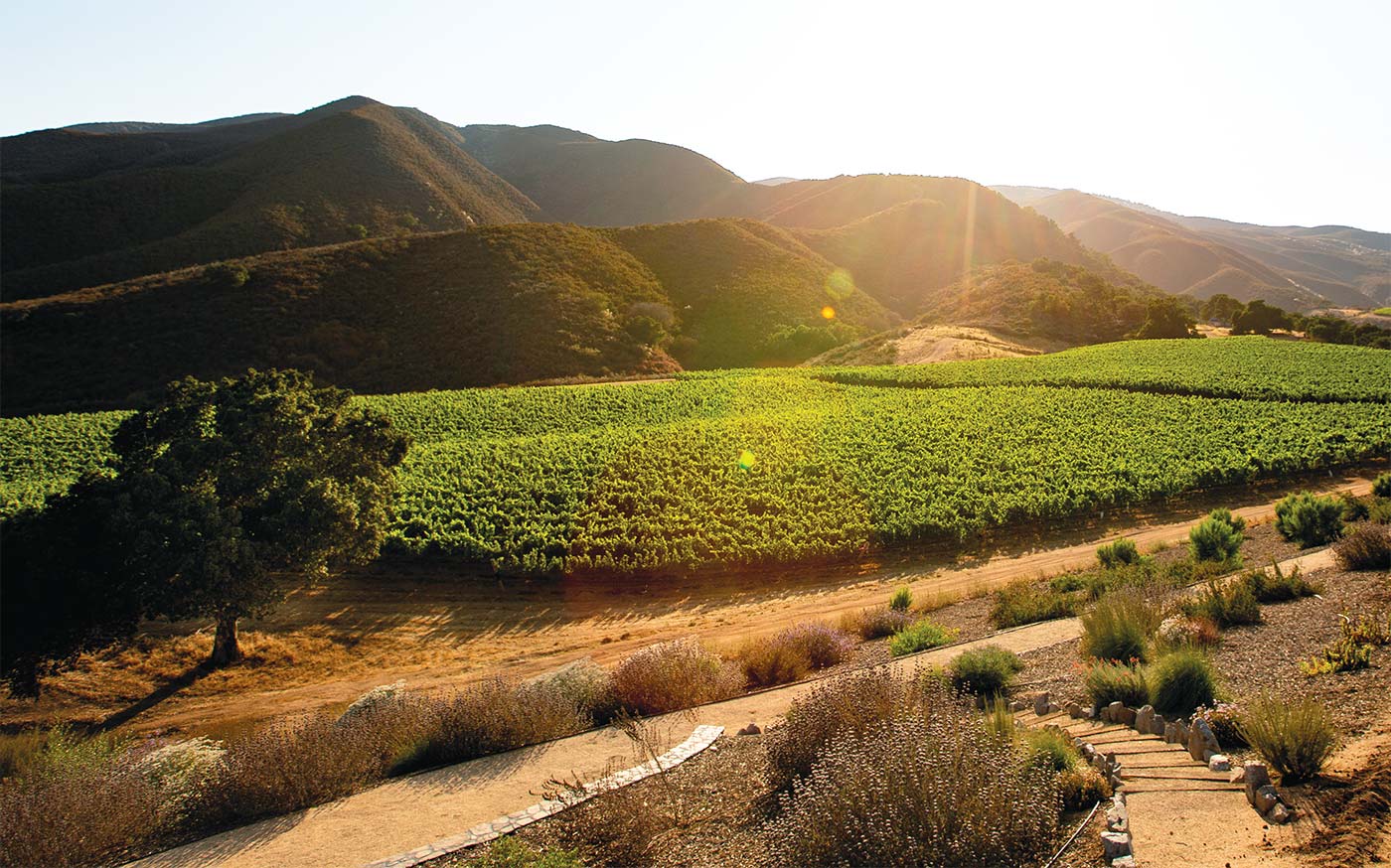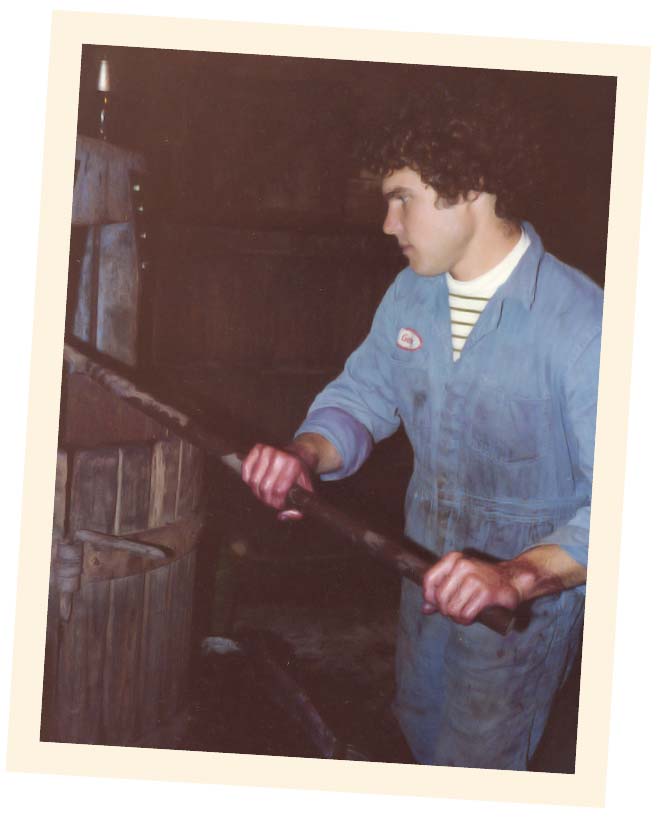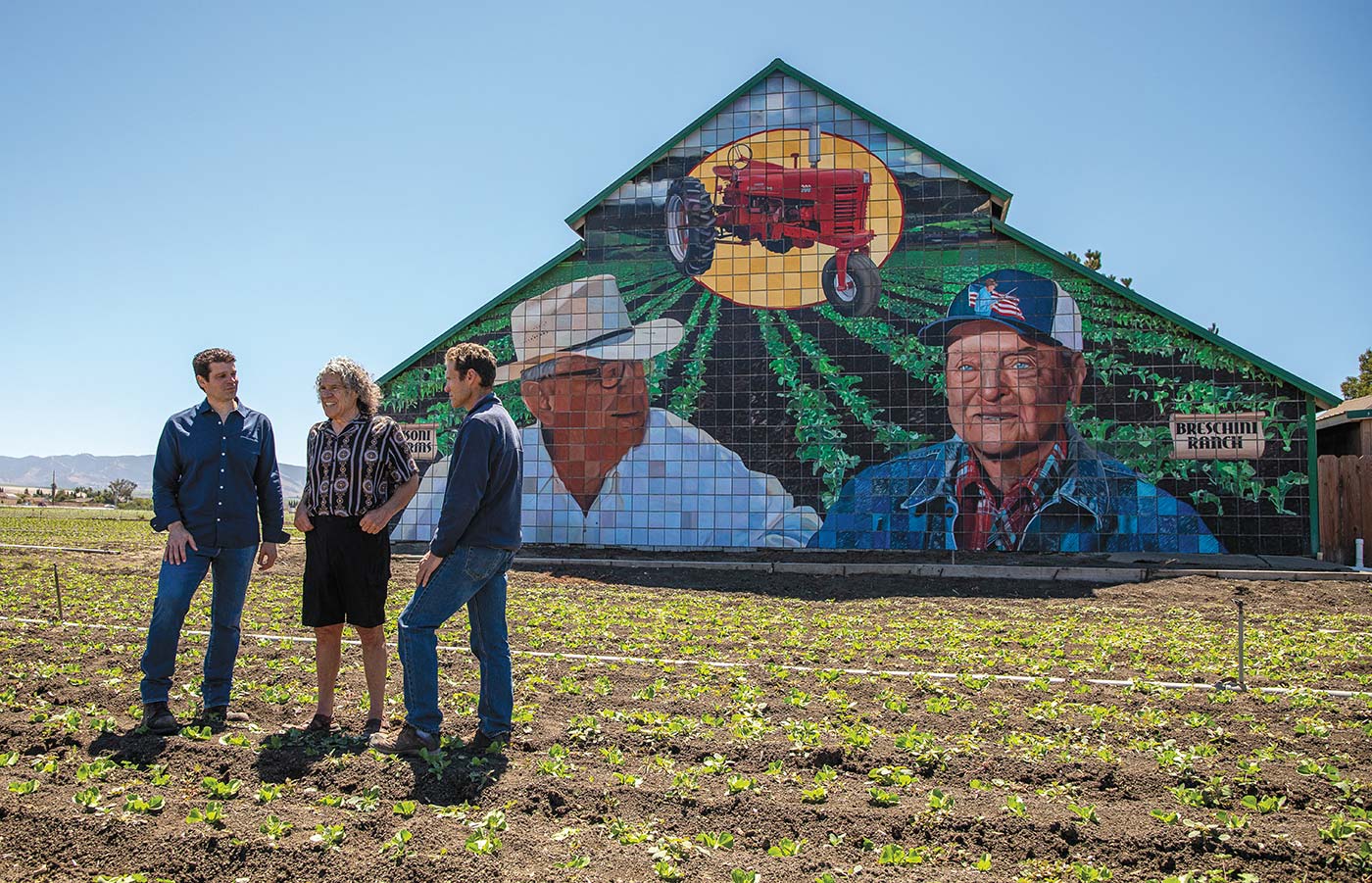
The Pisoni family writes a new chapter of Santa Lucia wine lore
Aromas of sun-baked lavender, California sagebrush and buckwheat waft in the stiffening morning breeze as I follow special projects manager Jazmin Lopez and winegrower Mark Pisoni into the two-acre insectary smack in the middle of Pisoni Vineyard.
The views of the Salinas Valley below are framed by manicured vine rows, which reveal evidence of recent leaf-thinning to expose the growing grape bunches to sunlight.
At the eastern edge of the Chardonnay block, this wildish garden is abuzz with activity.
I’ve never seen anything like it in a vineyard. For the Pisoni family, it represents another bold step in their quest to grow the very best grapes possible.
“Our name is on every bottle, and our reputation, too,” Pisoni says. “This is our land, our livelihood, our craft and our responsibility.” Planted by Lopez and the Pisoni vineyard team in 2018, the insectary provides habitat for beneficial bugs and also gives honeybees a year-round floral feast.
Lopez points out ceanothus, which blooms profusely in springtime—“ Bees love its small blue flowers,” she says—and another spring bloomer, black sage, which produces a beautiful, delicate honey. Each has its season, and purpose.
The native plants also attract pollinators like hummingbirds, parasitic wasps that feast on mealybugs, hoverflies that look like bees and discourage aphids, and ladybugs that feed on mites. The foliage also provides nesting materials for threatened bird species.
Gary Pisoni, way back in the day, before he had the juice to tell partner producers: “I have three rules to make wine here. You have to 1) be my friend, 2) make good wine, and 3) pay the bills!”

Beaming with the joy of a child beholding a butterfly for the first time, Pisoni explains the overall purpose of the plot is to help grow the best possible wine, sustainably and organically. He’s a stalwart steward of the land and its labor force, human and otherwise.
Perhaps the greatest pollinator of all in these parts, though, is Mark’s father, the legendary Gary Pisoni, a third-generation Salinas Valley vegetable farmer who as a college student became fascinated by the great wines of the Old World.
Returning home from a post-college visit to Europe in 1982, Gary told his father he was planting vines. His word choice has become foundational lore for the Santa Lucia Highlands that the Pisonis helped make famous: “Dad, have you ever heard of a $250 lettuce tasting?”
Unbeknownst to Gary at the time, his vision to plant vines would create an ecosystem upon which his generation and subsequent generations have grown to depend.
Now that his sons, Mark and Jeff— winegrower and winemaker, respectively— are firmly in charge, Gary Pisoni admits he had no inkling of the impact his vine adventure would have on his family, kids or the region.
“I was following my dream in a place that I thought would make amazing wine,” he says, noting there were only a few vineyards in the area circa 1982. “It seemed like no one else believed this could work!”
The Pisoni boys had a front row seat to all the excitement.
“I always thought it was so exciting,” Jeff says. “[My father] has amazing energy! I think boys want to follow what their dad does, and I was intrigued and enchanted by all that. People traveled from all over to a largely undiscovered area, just to meet him. I was a little in awe.”
Some of those people were grape buyers, others were winemakers and still others were wine writers, who began to transmit the tale that Gary was so adept at spinning.
“Remember,” Jeff says, “he was a psychology major.”
Jeff’s first internship, at Bernardus, came courtesy of his mom Roseann’s connections.
“My favorite thing was filling and racking barrels in the cellar,” says Jeff. “It was very neat, like a labyrinth. I loved working in the cool dark cellar. It was a very romantic side of wine, hanging out with barrels all day. I loved it!”
Today Jeff lives with his winemaker wife, Bibiana González Rave, and their two young sons in Santa Rosa, near the Pisoni winery facility, and he still loves hanging out with barrels in the cellar, where he crafts the wines under the Lucia, Lucy and Pisoni labels.
Like his dad, Mark Pisoni worked the fields as a kid but didn’t intend to be a farmer for life. After graduating from UC Davis in 1999, intent on research, he pursued his master’s at Cornell, envisioning an academic career where he would teach at the college level. But the ag life, and his grandfather’s failing health, called him back to the farm.
Says Gary, “I am thrilled to work with my two sons as they continue to build on what I started. One was naturally interested in farming, the other in wine. It worked out perfectly!”
Mark and Jeff inherited their father’s warmth, charm and enthusiasm, while tempering his legendary gregariousness with their mother’s focused calm. Both are engaging and passionate about their life’s work, and collaborate on all decisions from farming to barrel selection.
“We are all-organic here, and always have been,” Mark explains. “Farming this way takes more work—we touch each and every one of the vines at least 10 times throughout the growing season.”
Avoiding chemicals is paramount— with vegetables as well as grapes—so he’s using tools like pheromone traps to control mealybugs.
“I’m a happy guinea pig,” Mark says. “I’m willing to trial anything that can safely raise quality.”
In other words, premium grapes require fastidious attention, and it helps to get engaged from a young age.
“As kids, we would wake up early and help Dad in the barn where he kept the wine,” Jeff says. “He instilled in me early on how delicate Chardonnay and Pinot Noir are.”
Through Bernardus and other various internships, Jeff learned to treat each barrel as a separate lot and fermentation tracking the subtle variations in handling that impact wine quality.

“I think my family’s history and farming legacy are both really cool.”
Their winemaking facility is a completely practical and customized concrete building with multiple barrel rooms and temperature control, all driven by a desire for perfection.
“I meet regularly with the family regarding tanks, barrels and important winemaking decisions,” says Jeff. “It might be more expensive and time-consuming, but it’s all in the details.”
Mark lives with his wife, Quinn, and their two kids, in the Gonzales farmhouse previously occupied for 50 years by his great-uncle. They are surrounded by row crops, and he still farms 500 acres of romaine, broccoli and cauliflower, like his grandfather Eddie and his grandmother Jane—who in her 90s still signs all the paychecks—did before him.
This earth is sacred. The flavor of the asparagus the family once grew in abundance here is still vivid in my mind. Fortunately, Mark Pisoni’s broccoli is still legendary. But not as legendary as his grapes, which remain in demand.
Quinn, who met Mark at UC Davis where she studied crop science, says that living on a farm is like a shopkeeper living above their store.
“It’s awesome that our kids are growing up with a true understanding of what their dad does and how hard he and everyone on the ranch works,” she says.
Working summers on the ranch is giving both Avery (14) and Davis (16) a closer look at what it means to devote one’s life to agriculture.
Davis, who is currently helping the irrigation team on the row crops, sounds a bit like his father and uncle.
“Absolutely, I have always wanted to continue the family farming legacy,” he says. “I feel incredibly fortunate to be a part of something like this. I think my family’s history and farming legacy are both really cool.”
Avery, a gymnast, doesn’t seem quite so keen. She works in the vineyards, doing the nitty gritty of de-leafing and wire adjustment.
“I am learning how hard people have to work so that we can produce food to feed other people,” she says. “It is a very long process with lots of work to be able to grow vegetables and make wine.”
Asked if she would consider a career in farming, she replies “No.”
It’s not for everyone. But the family tradition perseveres across decades nonetheless.
Grandpa Gary provides perspective.
“I’m so proud of how my sons have taken our vineyard and winery to such a higher level than I ever could have imagined,” he says.
That so many great producers seek out this fruit, including Kosta Browne, Testarossa, Peter Michael, Furthermore, Siduri, Saxon Brown and Morgan, works as a testament to the label’s enduring appeal.
But Gary finds his peak satisfaction with a different metric.
“I’m especially proud of how our wines have been able to make so many people happy,” he says.
RARE PAIRING
How terroir-ifi c pioneers made partnership a superpower Back in the day, Gary Pisoni would drive around the Santa Lucia Highlands and see open pieces of land, always wondering what the wine from that site would taste like.
This led to a collaboration with Gary Franscioni.
Over a glass or two—or possibly three—of Pinot Noir at the Pisoni Vineyard, the two Garys discussed the current and future landscape of SLH, and made a handshake agreement to plant what would become known as Garys’ Vineyard.
“Our partnership then and now is built on growing the highest wine grape quality— and trust,” Franscioni says.
The two families have parlayed their joint passion to mutual benefi t, and a partnership now more than a quarter century—and two generations—in, as Gary Franscioni’s son Adam notes.
“Maintaining a relationship over that span—especially through the ups and downs of the wine industry—really speaks to the quality of the people they are and the strength of the relationship we’ve built,” says Adam, vineyard manager at ROAR, the Franscioni family’s label. “They are incredibly dedicated to farming high-quality fruit and producing exceptional wines.”
Adam’s brother Nick, ROAR’s winery manager, views a concern often raised about both families making wine from the same vineyards—that they’re competing against themselves—as an opportunity.
“While our styles are diff erent, I only see the advantages of competing’ against a high-quality producer like them,” says Nick. “They push us to make better wine and ultimately help raise the bar for what is possible in our appellation.”
About the author
Laura Ness is a longtime wine journalist, columnist and judge who contributes regularly to Edible Monterey Bay, Spirited, WineOh.Tv, Los Gatos Magazine and Wine Industry Network, and a variety of consumer publications. Her passion is telling stories about the intriguing characters who inhabit the fascinating world of wine and food.
- Laura Nesshttps://www.ediblemontereybay.com/author/lness/
- Laura Nesshttps://www.ediblemontereybay.com/author/lness/
- Laura Nesshttps://www.ediblemontereybay.com/author/lness/
- Laura Nesshttps://www.ediblemontereybay.com/author/lness/


